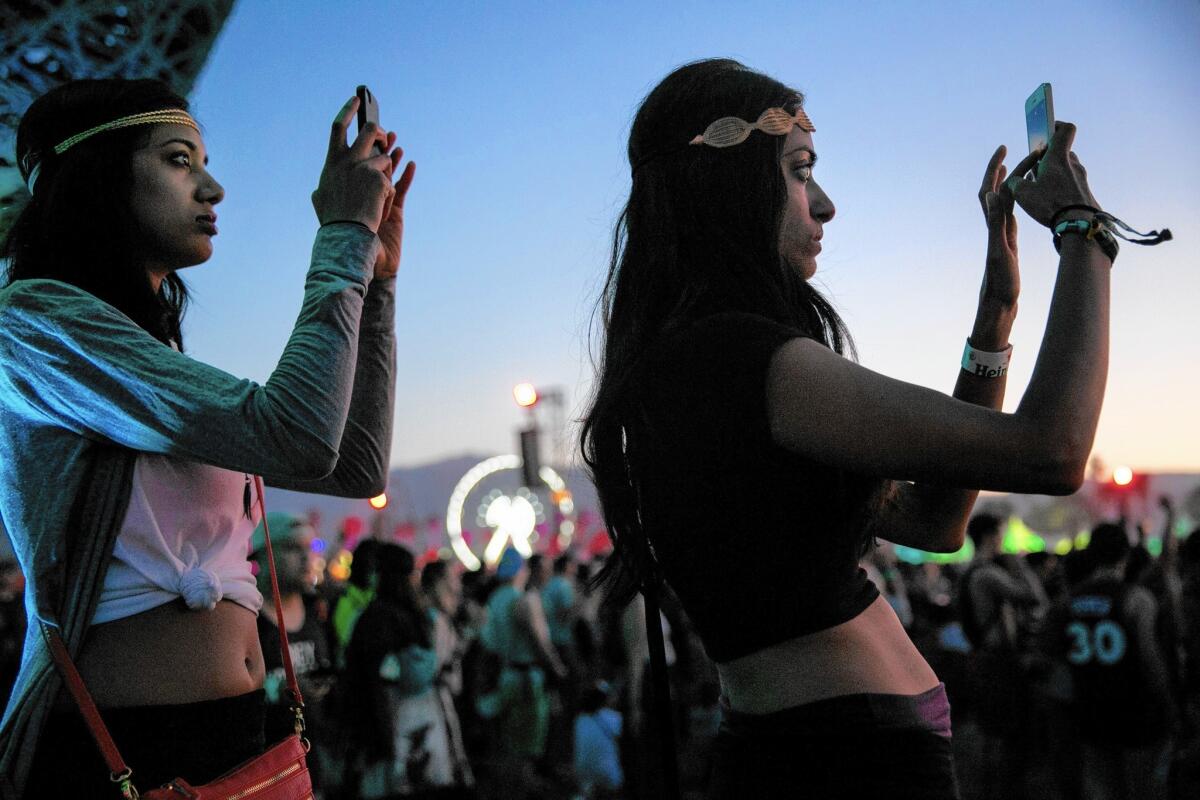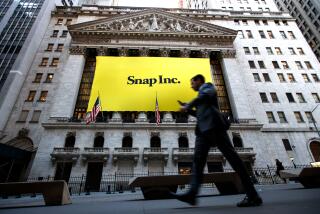Cheap content, growing reach make Snapchat a fast-rising star

- Share via
Thousands of revelers descended on the Coachella music festival last weekend to rock out to their favorite bands and party day and night. But a far bigger audience from around the world — at least 40 million — joined in remotely through video snippets from Snapchat.
Those snippets, no more than 10 seconds long — bands on stage, crazy dancers, people in swimsuits gliding down a Slip ‘n Slide — were shot and posted by Snapchat users at no cost to Snapchat. The fast-growing Venice start-up simply stitched clips together using software. It’s now selling advertising for those programs; with free content, the profit margins would be huge.
Critics dismissed Snapchat early on as a smartphone app that didn’t do much but let lovers trade the type of photos they didn’t want saved. But the huge audiences that Snapchat is gathering on a new feature called Stories is the latest example of how a tiny company can rise up fast with a business strategy that could make it the next hot technology sensation out of California — much like Facebook in its early days. Early Stories advertisers include Coca-Cola, Universal Pictures, Macy’s and Samsung.
Consider the potential: Top broadcast shows, such as CBS’ “NCIS,” average about 20 million viewers, half the Coachella audience. Snapchat’s reach, advertising industry analysts say, is big enough to siphon ad dollars otherwise spent on television and YouTube.
“You have a TV-sized audience all viewing at once, or at least within a day,” said Michael Boland, chief analyst at ad consultancy BIA/Kelsey. “Brand advertisers really like that.”
The under-35 crowd, spending less time with TV, has been a pesky lot to track down for advertisers, but Snapchat is among the few social media apps in which they see possibility. Spending on mobile ads that take a user’s location into account is expected to balloon to $19.3 billion in 2018 from $4.3 billion in 2014, according to BIA/Kelsey. Snapchat aims to take a big piece.
There’s no certainty that it will. The private company’s profits will have to be huge and sustained for many years before it can justify its market value, reputedly about $15 billion based on recent venture capital investments.
That assumes some hefty advertising revenue. Adweek reported this year that the company was asking brands for $750,000 a day to place ads on the platform. Snapchat declined to say how much it makes from advertisers.
Facebook, founded in 2004, de-emphasized advertising in its early years, when founder and Chief Executive Mark Zuckerberg talked about building a social network first. When it got big enough, advertising dollars would follow, and they did. Now Facebook is becoming a channel for videos and other content and is pulling in annual revenue of $12 billion a year and growing.
Snapchat is taking a more aggressive approach to ad revenue than Facebook did. The disappearing message feature grew fast by attracting mostly young users who sought a more shrouded social network than the highly public Facebook could provide. And then it took off yet again as it added mobile video. When Facebook launched, technology for online video was still fairly crude.
Snapchat’s content is cheap. User-sent video costs next to nothing — just some software and human curators to piece together compelling snippets, which differs substantially from the disorganized mess that confronts visitors to YouTube.
Snapchat gets free content from media companies too, some of it high quality. Snapchat’s new Discover feature displays buttons that take Snapchat users into short, splashy video productions by Vice, CNN, National Geographic and others. Advertisers on Discover include Verizon, BMW and Sperry Top-Sider.
Forget profits for now, though. It’s believed that Snapchat barely brings in any revenue, with its experiments in advertising at an early stage.
Still, the nearly 4-year-old company’s success with new forms of ephemeral content is likely to keep early investors happy.
“I see what Snapchat is doing around Stories and Discover, and I feel it’s safe to assume that Snapchat will become a viable platform for video advertising,” said Jared Lake, director of digital strategy at ad buying agency Ocean Media. “They have some refining to do, but I would be shocked if they didn’t get there very soon.”
The success with Coachella highlights the possibilities for Stories, a grass-roots look into what life is like at festivals, award shows, sporting matches, college campuses and cities near and far. The glimpses of daily life are organized into three- to five-minute videos by a small team of Snapchat employees. Their source material: hundreds of hours of user-generated photos and videos. Attention from Snapchat can amplify the chatter about an overlooked event — like last weekend’s Oxford vs. Cambridge boat race on the River Thames — as much as a highly orchestrated TV production.
Requests for certain events flood Snapchat workers on Twitter and email, cluing them in to items the company might never have imagined: cheerleading competitions, university dance-a-thons, horse races. Each clip in a story is available for 24 hours only; then it disappears.
Over the weekend, Jaime Bonventre captured a bittersweet moment in sports history she thought a few fellow fans would also enjoy: a six-second recording of a worker pushing a goal cage off the ice after the New York Islanders played their final regular season game at Nassau Coliseum.
She didn’t expect 3.6 million people to watch the clip, included in a Snapchat compilation featured in the app as “Our Islanders Story.”
“It was just insane,” said Bonventre, 26, a social media producer at News 12 Networks in Long Island, N.Y., who ended her snap with a sad face emoji.
Bonventre has been a Snapchat fan since the app became available, checking daily compilations from various cities and events.
“Like Coachella, those were awesome,” she said. “It made me wish I was there.”
With more than 100 Stories produced since last June, Snapchat is taking its digital jet-setting to more exotic locales.
On Tuesday, for the first time, Snapchat reported back from Dubai, where a camel tanned on the beach, a man troubled by sweltering heat U-turned back into the shade and jet skiers raced along the shore, all pieced together from images users uploaded with a tap on a smartphone screen. Snapchat zeroed in on Toronto and Seattle over the next two days.
Stories for Los Angeles and New York City, the two cities where Snapchat has offices, have become mainstays since launching in February and have drawn millions of views a day. Snapchat also has produced Stories for 70 college campuses, though the videos are viewable only to those nearby.
“The experience is through the lens of the community, and that human perspective is pretty unique and exciting,” Snapchat spokeswoman Mary Ritti said.
On the Los Angeles video midday Thursday, viewers were greeted with videos of chicks, kittens and lizards, then a woman signaling out a message for American Sign Language Day, followed by a trio of Lakers thanking fans after a miserable season.
Jenny Chao recently shot dancing rollerbladers at Davey Wayne’s, a retro 1970s bar in Hollywood, which found its way into the Los Angeles story.
“It was cool to get into L.A. Stories,” said Chao, an account executive at Moxie Communications, a public relations firm with offices in Marina del Rey. But she’s not desperate. “It’s not like my fingers are crossed all the time that I’ll make it.”
Snapchat is playing with ways to incorporate ads into the new features. It has slipped advertising in between clips in a few event-based Stories, but not yet into any city- or college-themed ones.
It’s the latter group, however, that could widen Snapchat’s revenue potential as it taps into niche or regional advertisers in thousands of markets, not just national accounts such as Verizon Wireless and Sperry Top-Sider.
“Multi-location businesses, restaurants, retail or down even further to the small-business marketing space,” said Boland, the analyst. “The more fragmented universe of local advertisers is where Snapchat could really get scale.”
The ads probably would have to remain high-quality, vertically shot, short and sporadic — as they are now — according to experts. Snapchat’s avoidance of sloppy and infuriating ads is paying off, said Stephen Boidock, social engagement director for the Austin, Texas-based advertising agency Drumroll.
“What’s great about Snapchat is they’re learning how people use the tools and apps to create the best way to integrate advertising naturally,” Boidock said.
Twitter: @peard33
Twitter: @dhpierson
More to Read
Inside the business of entertainment
The Wide Shot brings you news, analysis and insights on everything from streaming wars to production — and what it all means for the future.
You may occasionally receive promotional content from the Los Angeles Times.












